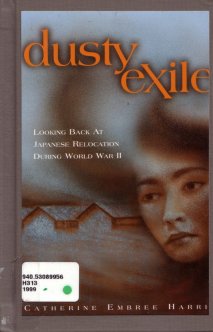
Dusty Exile: Looking Back on Japanese Relocation During World War II

Catherine Embree Harris, 1999
The author is not a Japanese American. She did work at one of the internment camps as a staff member and thus this makes her book quite different from books written by the internees themselves, or by the people who were making the decisions (or about the people making the decisions) on what was done.
After working at a bookstore she applied at the Office of Indian Affairs for a job but ended up instead being asked if she would work at a relocation camp. She had many pleasant memories of Japanese from her when she was growing up in Hawaii and thought it would be something she looked forward to doing.
She then goes into the history of the rounding up and evacuation of the Issei and Nisei, including the assembly centers. The book has numerous photos not seen elsewhere, too.
She took a job as an assistant teacher at the Poston internment camp in Arizona. She describes her roommate at the camp and talks a little about the physical setup the staff had which was better than that for the internees, but not always a whole lot better.
She talks about how the camps were constructed and about the other teachers she would be working with. She then covers the differences between the Issei, the Nisei and the Kibei in particular.
There were 5,300 school children at Poston. There were never enough teachers, and turnover was rapid. Although she had signed up as an assistant teacher, she was put into a full teacher's position. They had no schoolbooks until three months after the schools started. Although there were science and cooking classrooms, and auto mechanics and woodworking shops, none of them were wired for electricity or even had running water.
The author was a 9th grade teacher. Various other teachers showed up, with the author going back to an assistant teacher status, but each teacher left relatively quickly until the fourth who turned out to be a Quaker woman who stayed till the camp closed in 1945.
She talks about the nearby town of Parker and how it was extremely anti-Japanese, especially when any of the students or other internees stopped in the town during one of the out-of-camp-work excursions. She then goes on to talk about various things the internees did involving the arts and crafts and churches.
She also talks about many of the problems that the camp had including food shortages, the cultural shock to Issei males who no longer were the actual working heads of their families, etc. She also notes that Poston had no guard towers nor barbed wire fencing, just regular fencing around it.
She writes about a beating that took place in the camp and how the FBI became involved. 50 men had been interviewed and the field was cut down to 2 suspects although no one knew why the two men in particular were picked and not the others. The people in the camp were worried that the men would be removed and tried somewhere else and they tried to testify to the good character of both suspects.
The camp kept referring all requests and petitions for release to the FBI who ignored them. Certain key people were not present in the camp and in their absence a general strike was called. It was also a power struggle between the Issei, the Nisei and the Kibei.
A rather polite strike was called since the strike would not cover food delivery, the hospital, schools, fire protection, internal security or garbage collection. In the end, after a lot of bad tempers and frayed nerves, some solid negotiations were held and things ended up working out fine.
She then discusses how some of the evacuees ended up in the U.S. military doing valuable work. Then came the loyalty questionnaire and the "no-no's". She notes that 4,724 evacuees eventually returned to Japan.
She writes about how many students were placed into colleges throughout the U.S., including Swarthmore and Berea. She also writes about how some of the evacuees were resettled in the East and how that affected the number of teachers and students left in the camp. She then covers the end of the war and the disbanding of the camp.
She talks about what some of the people she worked with did after the camp was closed and then about the redress efforts.
This is a very interesting book, especially since it's told first-hand by a person directly involved in what was going on. It maintains a person's interest throughout.
Main Index
Japan main page
Japanese-American Internment Camps index page
Japan and World War II index page
|